Scientific name
Amitus spp. Foerster
Taxonomic position
Hymenoptera: Platygastroidea: Platygastridae
Diagnosis
Body dark brown to black, dorsoventrally flattened with long wings. Head from above distinctly transverse, opisthognathous in lateral view. Female antenna appearing to be 8-segmented, with abrupt, ovoid to spindle-shaped club actually comprising three-segments, which appear to be fused, sometimes club appears to have 2 faint traces of sutures. Male antenna 10-segmented. Abdomen short, subsessile, broad, nearly as long as wide; second segment largest of all; tergite 1 strongly trapezoidal-transverse, tergite 2 with series of striae anterolaterally. Fore wing with long marginal fringe of hairs, devoid of venation except for a rudimentary submarginal vein in basal part. Legs long and slender, with tibial spur formula 1-1-1, fore tibial spur distinctly bifid; tarsi 5-segmented in all pairs of legs.
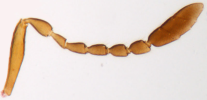
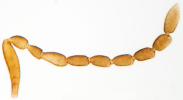 Antenna - female (left) and male (right) Antenna - female (left) and male (right)
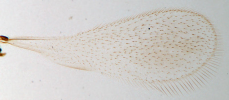 Forewing Forewing
Images

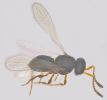
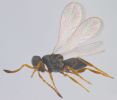 Adult - dorsal, lateral view (1 and 2) and adult in profile (3) Adult - dorsal, lateral view (1 and 2) and adult in profile (3)

 Thorax and gaster, dorsal view Thorax and gaster, dorsal view
Distribution
Almost cosmopolitan. Some species are nearly cosmopolitan in distribution due to introductions.
Biology / Hosts
All the known species of Amitus are parasitoids of whiteflies (Hemiptera: Aleyrodidae). Amitus aleurolobi Mani is a parasitoid of Aleurolobus barodensis in India.
Reference
- Mani, M.S. & Sharma, S.K. 1982. Proctotrupoidea (Hymenoptera) from India: A Review. Oriental Insects, 16(2): 135-258.
|